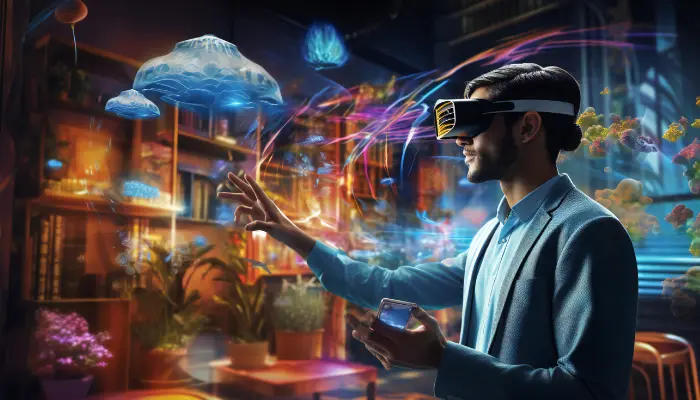
In today’s fast-paced digital landscape, augmented reality (AR) marketing emerges as a groundbreaking tool, offering brands a unique way to engage their audience with immersive experiences. Unlike traditional marketing methods, AR marketing transcends the limitations of the two-dimensional world, inviting consumers into a vibrant, interactive environment where the lines between the physical and digital blur. This innovative approach not only captivates users but also significantly enhances brand visibility and customer engagement.
Augmented reality, once a figment of science fiction, has rapidly evolved into a tangible, influential force in the marketing domain. Thanks to advancements in technology and the widespread adoption of smartphones and AR-compatible devices, marketers now have the power to craft experiences that were unimaginable a decade ago. AR marketing does not merely present information; it brings products and services to life, allowing consumers to interact with them in real time, in their own space.
Also Read: Hyperlocal Targeting: Precision Marketing for Small businesses in the Digital Space
The essence of AR marketing lies in its ability to create deeply engaging and memorable experiences. By overlaying digital information in the real world, brands can deliver personalized content that resonates with their audience on an emotional level. Imagine trying on sunglasses from your favorite fashion brand through your smartphone camera or visualizing how a piece of furniture would look in your living room before making a purchase. These experiences not only simplify the decision-making process but also forge a stronger connection between the brand and its consumers.
Also Read: Dark Social: Understanding and Utilizing the Hidden Channels of Digital Sharing
One of the key strengths of AR marketing is its unparalleled capacity for personalization. AR technology can tailor experiences to individual users based on their location, behavior, and preferences, making every interaction unique. This level of personalization not only enhances user satisfaction but also boosts the likelihood of conversion, as consumers feel more connected and understood by the brand.
Also Read: Personal Branding in the Digital Age: Establishing Authority and Influence Online
In an era where attention is a scarce commodity, AR offers a compelling solution. By crafting interactive and engaging experiences, brands can capture the attention of their audience in a saturated market. AR campaigns are inherently shareable, often going viral on social media, thereby amplifying brand visibility far beyond traditional advertising means. Furthermore, by offering value through entertainment or practical utility, AR encourages users to spend more time engaging with the brand, thereby deepening their relationship and fostering loyalty.

While AR marketing holds immense potential, it also presents its set of challenges. High development costs and the need for technological expertise can be barriers for some brands. Additionally, creating experiences that genuinely add value requires a deep understanding of the target audience and their needs. However, with the rapid advancement of AR platforms and tools, these challenges are becoming increasingly surmountable, paving the way for more brands to explore the possibilities of AR marketing.
Several brands have already leveraged AR to remarkable effect. For instance, IKEA’s Place app allows users to visualize how furniture would look and fit in their space before making a purchase, effectively reducing hesitation and improving customer satisfaction. Similarly, beauty brands like Sephora and L’Oréal have introduced AR mirrors and apps, enabling customers to try on makeup virtually, thus enhancing the shopping experience and driving sales.
As technology continues to evolve, the future of AR marketing looks exceptionally bright. With the advent of wearable AR devices and improvements in spatial computing, AR experiences will become even more immersive and seamless. Furthermore, as more data becomes available, personalization will reach new heights, offering experiences that are not just tailored to individual preferences but also adaptive to real-time changes in those preferences.
The ultimate promise of AR marketing is to create a harmonious blend of the physical and digital worlds, where interactions with brands are as natural and engaging as conversations with friends. In the future, AR will not just be a marketing tool but a fundamental aspect of how we live, work, and play.
Augmented reality marketing represents a paradigm shift in how brands interact with their audience. By creating immersive experiences that captivate and engage, AR not only enhances brand visibility but also fosters a deeper connection with consumers. As we look to the future, it is clear that AR will play a pivotal role in the evolution of marketing, transforming passive observers into active participants in the brand story. For marketers willing to embrace this technology, the possibilities are as limitless as the virtual landscapes they can create.
Recent Posts
Categories
Our Address:
2nd Floor, H-187, Block – H, Sector 63, Noida, Uttar Pradesh 201301, India
Phone: +91-8882811078
Email: hello@digidiracademy.com
©2025. DigiDir Academy, Digital Marketing Training in Noida. All Rights Reserved.
You can see how this popup was set up in our step-by-step guide: https://wppopupmaker.com/guides/auto-opening-announcement-popups/